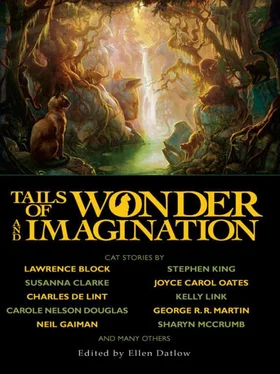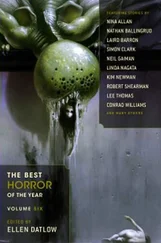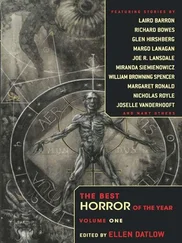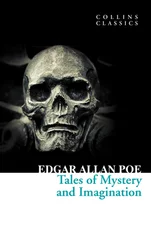Ellen Datlow - Tails of Wonder and Imagination
Здесь есть возможность читать онлайн «Ellen Datlow - Tails of Wonder and Imagination» весь текст электронной книги совершенно бесплатно (целиком полную версию без сокращений). В некоторых случаях можно слушать аудио, скачать через торрент в формате fb2 и присутствует краткое содержание. Год выпуска: 2010, ISBN: 2010, Издательство: Night Shade Books, Жанр: Фэнтези, Фантастика и фэнтези, Ужасы и Мистика, на английском языке. Описание произведения, (предисловие) а так же отзывы посетителей доступны на портале библиотеки ЛибКат.
- Название:Tails of Wonder and Imagination
- Автор:
- Издательство:Night Shade Books
- Жанр:
- Год:2010
- ISBN:978-1-59780-170-6
- Рейтинг книги:5 / 5. Голосов: 1
-
Избранное:Добавить в избранное
- Отзывы:
-
Ваша оценка:
- 100
- 1
- 2
- 3
- 4
- 5
Tails of Wonder and Imagination: краткое содержание, описание и аннотация
Предлагаем к чтению аннотацию, описание, краткое содержание или предисловие (зависит от того, что написал сам автор книги «Tails of Wonder and Imagination»). Если вы не нашли необходимую информацию о книге — напишите в комментариях, мы постараемся отыскать её.
collects the best of the last thirty years of science fiction and fantasy stories about cats from an all-star list of contributors.
Tails of Wonder and Imagination — читать онлайн бесплатно полную книгу (весь текст) целиком
Ниже представлен текст книги, разбитый по страницам. Система сохранения места последней прочитанной страницы, позволяет с удобством читать онлайн бесплатно книгу «Tails of Wonder and Imagination», без необходимости каждый раз заново искать на чём Вы остановились. Поставьте закладку, и сможете в любой момент перейти на страницу, на которой закончили чтение.
Интервал:
Закладка:
It occurs to you that you could throw this Maybe Albino like a baseball. You could wind up like Denny McLain and fling it at the far wall of the grain crib. If you aim just right, you may be able to hit the wall so that the kitten rebounds and lands on Sky. You could sing a funny song, “Sky’s being fallen on, / Oh, Sky’s being fallen on, / Whatcha think ’bout that?” And nobody’ll ever know if poor little Maybe Albino has pink eyes or not….
This sudden impulse horrifies you, even as a kid, especially as a kid. You can see the white kitten dead. Trembling, you set the kitten back down on the cardboardy deer hide, climb back over the crib rail, and stand away from the naked litter while Sky tries to decide what to do next.
Unmanfully you start to cry. “S-sorry, k-kitty. S-s-sorry, Sk-sky. I’m r-r-really s-sorry.” You almost want Gramby or Meemaw Anita to stumble in on you, in the churchly gloom and itch of their grain crib, to see you doing this heartfelt penance for a foul deed imagined but never carried out. It’s okay to cry a bit in front of your mama’s folks.
I’m touched, Penfield says. But speak up. Stop mumbling.
For several months after your senior year, you reside in the Adolescent Wing of the Quiet Harbor Psychiatric Center in a suburb of Atlanta. You’re there to neutralize the disorienting stimuli—flak, you call it—burning out your emotional wiring, flying at you from everywhere. You’re there to relearn how to live with no despairing recourse to disguises, sex, drugs.
Bad drugs, the doctors mean.
At QHPC, they give you good drugs. This is actually the case, not sarcastic bullshit. Kim Yaughan, one of the psychotherapists in the so-called Wild Child Wing, assures you that this is so; that antipsychotics aren’t addictive. You get twenty milligrams a day of haloperidol. You take it in liquid form in paper cups shaped like doll-house-sized coffee filters.
“You’re not an addict,” Kim says. (Everyone at QHPC calls her Kim.) “Think of yourself as a diabetic, of Haldol as insulin. You don’t hold a diabetic off insulin, that’d be criminal.”
Not only do you get Haldol, you get talk therapy, recreational therapy, family therapy, crafts therapy. Some of the residents of the Wild Child Wing are druggies and sexual-abuse victims as young as twelve. They get these same therapies, along with pet therapy. The pets brought in on Wednesdays often include cats.
At last, Penfield tells an associate. That last jolt wasn’t a mis-hit, after all.
The idea is that hostile, fearful, or withdrawn kids who don’t interact well with other people will do better with animals. Usually, they do. Kittens under a year, tumbling with one another, batting at yarn balls, exploring the pet room with their tails up like the radio antennas on cars, seem to be effective four-legged therapists.
One teen-age girl, a manic-depressive who calls herself Eagle Rose, goes ga-ga over them. “Oh,” she says, holding up a squirmy smoke-colored male and nodding at two kittens wrestling in an empty carton of Extra Large Tide, “they’re so soft, so neat, so… so highly lustrous.”
Despite Kim Yaughan’s many attempts to involve you, you stand aloof from everyone. It’s Eagle Rose who focuses your attention, not the kittens, and E.R.’s an untouchable. Every patient here is an untouchable, that way. It would be a terrible betrayal to think anything else. So, mostly, you don’t.
The year before you marry, Marti is renting a house on North Highland Avenue. A whole house. It’s not a big house, but she has plenty of room. She uses one bedroom as a studio. In this room, on the floor, lies a large canvas on which she has been painting, exclusively in shades of blue, the magnified heart of a magnolia. She calls the painting—too explicitly, you think— Magnolia Heart in Blue. She’s worked on it all quarter, often appraising it from a stepladder to determine how best to continue.
Every weekend, you sleep with Marti in the bedroom next to the studio. Her mattress rests on the floor, without box springs or bedstead. You sometimes feel that you’re lying in the middle of a painting in progress, a strange but gratifying sensation that you may or may not carry into your next week of classes at GSU.
One balmy Sunday, you awake to find Marti’s body stenciled with primitive blue flowers, a blossom on her neck, more on her breasts, an indigo bouquet on the milky plane of her abdomen. You gape at her in groggy wonderment. The woman you plan to marry has become, overnight, an arabesque of disturbing floral bruises.
Then you see the cat, Romeo, a neighbor’s gray Persian, propped in the corner, belly exposed, so much like a hairy little man in a recliner that you laugh. Marti stirs. Romeo preens. Clearly, he entered through a studio window, walked all over Magnolia Heart in Blue, then came in here and violated Marti.
My wife-to-be as a strip of fin de siècle wallpaper, you muse, kissing her chastely on one of the paw-print flowers.
You sleep on the streets. You wear the same stinking clothes for days on end. You haven’t been on haloperidol for months. The city could be Lima, or Istanbul, or Bombay, as easily as Atlanta. Hell, it could be a boulder-littered crater on the moon. You drag from one place to another like a zombie, and the people you hit up for hamburgers, change, MARTA tokens, old newspapers, have no more substance to you than you do to them, they could all be holograms or ghosts. They could be androids programmed to keep you dirty and hungry by dictating your behavior with remote-control devices that look like wristwatches and key rings.
Cats mean more to you than people do. (The people may not be people.) Cats are fellow survivors, able to sniff out nitrogenous substances from blocks away. Food.
You follow a trio of scrawny felines down Ponce de Leon to the rear door of a catfish restaurant where the Dumpster overflows with greasy paper and other high refuse. The cats strut around on the mounded topography of this debris while you balance on an upturned trash barrel, mindlessly picking and choosing.
Seven rooms away from Coach Osteen’s lab, Mr. Petty is teaching advanced junior English. Poetry. He stalks around the room like an actor doing Hamlet, even when the poem’s something dumb by Ogden Nash, or something beat and surface-sacrilegious by Ferlinghetti, or something short and puzzling by Carlos Williams.
The Williams piece is about a cat that climbs over a cabinet—a “jamcloset”—and steps into a flowerpot. Actually, Mr. Petty says, it’s about the image created by Williams’s purposely simple diction. Everyone argues that it isn’t a poem at all. It’s even less a poem, lacking metaphors, than that Carl Sandberg thing about the fog coming on little, for Christ’s sake, cat’s feet.
You like it, though. You can see the cat stepping cautiously into the flowerpot. The next time you’re in Coach Osteen’s class, trying to redeem yourself at the dissection table, you recite the poem for Pamela van Rhyn, Jessie Faye Culver, Kathy Margenau, and Cynthia Spivy.
Coach Osteen, shaking his head, makes you repeat the lines so that he can say them, too. Amazing.
“Cats are digitigrade critters,” he tells the lab. “That means they walk on their toes. Digitigrade.”
Cynthia Spivy catches your eye. Well, I’ll be a pussywillow, she silently mouths. Who’d’ve thunk it?
“Unlike the dog or the horse,” Coach Osteen goes on, “the cat walks by moving the front and back legs on one side of its body and then the front and back legs on the other. The only other animals to move that way are the camel and the giraffe.”
Читать дальшеИнтервал:
Закладка:
Похожие книги на «Tails of Wonder and Imagination»
Представляем Вашему вниманию похожие книги на «Tails of Wonder and Imagination» списком для выбора. Мы отобрали схожую по названию и смыслу литературу в надежде предоставить читателям больше вариантов отыскать новые, интересные, ещё непрочитанные произведения.
Обсуждение, отзывы о книге «Tails of Wonder and Imagination» и просто собственные мнения читателей. Оставьте ваши комментарии, напишите, что Вы думаете о произведении, его смысле или главных героях. Укажите что конкретно понравилось, а что нет, и почему Вы так считаете.












